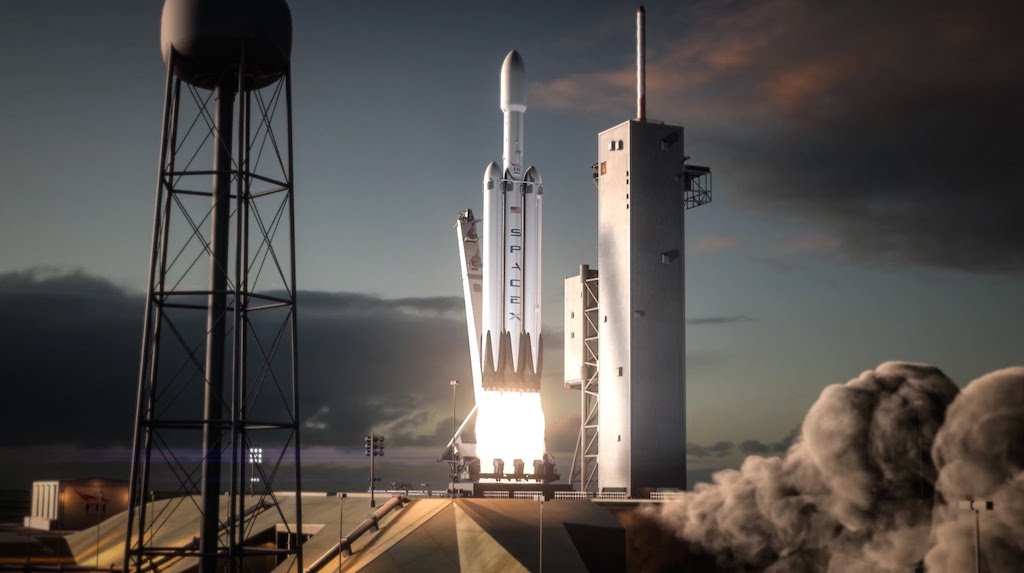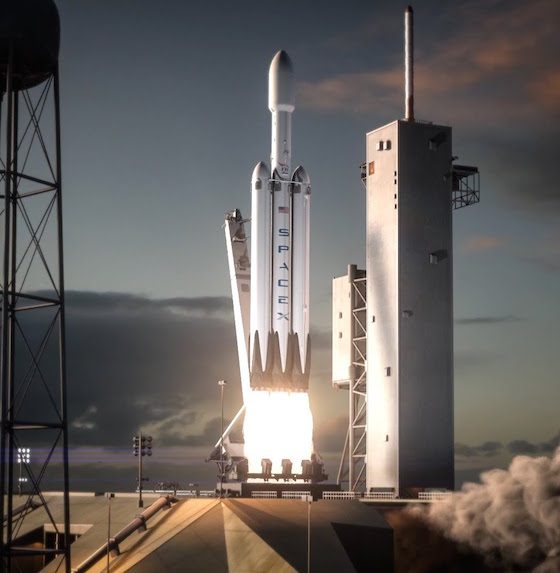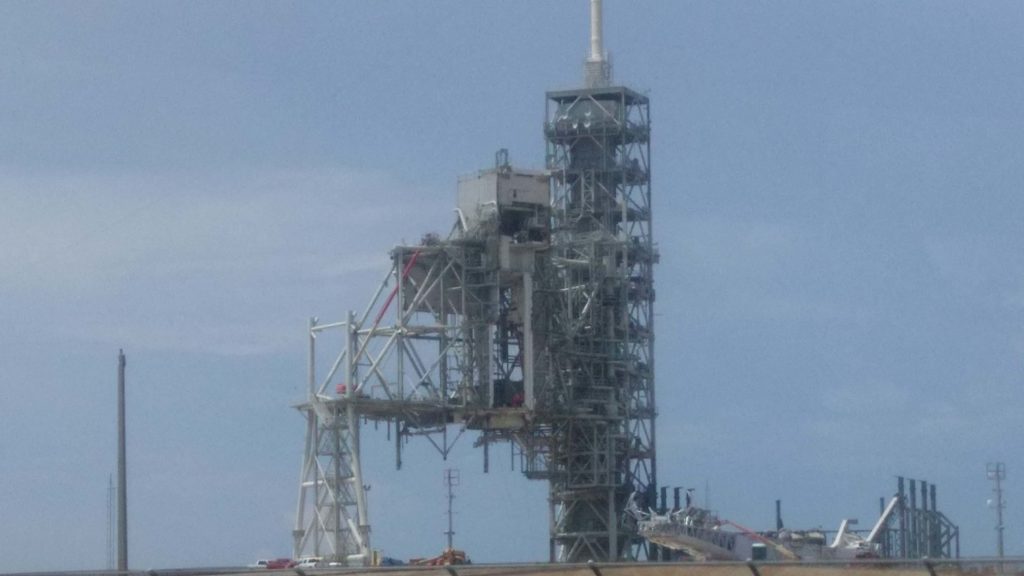

News
SpaceX preparing for an inaugural Falcon Heavy launch in November
All three Falcon Heavy cores are believed to be at Cape Canaveral
As we inch closer to SpaceX returning to a regular launch schedule, evidence is adding up that Falcon Heavy is fast approaching launch readiness.
Over at SpaceX’s Cape Canaveral facilities, workers are busily modifying LC-39A and are deep into the reconstruction and reactivation of LC-40, which was severely damaged just over 11 months ago. Members of the SpaceX fan community have taken regular tours of the Kennedy Space Center and offered glimpses into part of the process as workers relentlessly dismantle previous LC-39A pad structures.
- During a month without launches, SpaceX has made considerable progress dismantling parts of LC-39A. The main focus right now is the RSS, which is the skeletal structure on the left. (Brian Bundridge/Facebook)
- One of Falcon Heavy’s side boosters seen arriving at LC-39A about a month ago. (Reddit /u/MajorRocketScience)
Before SpaceX, the pad hosted the first manned launches of the vast Saturn V rocket and hosted the launch of Apollo 11, which landed the first humans on the Moon in 1969. Decades later, that same pad was recycled for the Space Shuttle and supported dozens of Shuttle launches. SpaceX is deep into the process of dismantling the old pad structures used for the Shuttle, and Elon Musk has recently reported that the Rolling Service Structure (RSS) is expected to be entirely removed before the first launch of Falcon Heavy. While bittersweet for many observers, LC-39A will eventually host both the return of massive rockets to the U.S., as well as the first American-supported launch of crew to the ISS in more than six years.
With this progress, we find ourselves in the pleasantly foreign situation of SpaceX beating one of Musk’s aggressive schedules. In early June, he tweeted about Falcon Heavy cores arriving at the Cape within two or three months. Surprisingly, it has been confirmed that three of three Falcon Heavy cores are already at LC-39A and have been for at least a week or two. At the moment, pad readiness is the main constraint for its inaugural launch. SpaceX is preparing for a period of pad gymnastics as they ready LC-40 to take over for LC-39A. Once this happens, all Falcon 9 launches will be transferred over to LC-40, and this will allow SpaceX workers to conduct necessary modifications to LC-39A’s launch hardware in preparation for Falcon Heavy. These modifications are expected to take about two months.
All Falcon Heavy cores should be at the Cape in two to three months, so launch should happen a month after that
— Elon Musk (@elonmusk) June 8, 2017
Current best guesses peg the first launch from LC-40 in late August or sometime in September, fitting nicely with Musk’s Falcon Heavy launch estimate of November. Falcon Heavy will nevertheless likely require several weeks of fit checks, wet dress rehearsals (like a static fire but without the ignition), and one or several static fires before its first official launch attempt. While Musk has recently been on a warpath of expectation management for Falcon Heavy, going so far as to imply that a failure was a likely outcome, let there be no doubt that SpaceX and Musk will privately do everything realistically possible to ensure a safe launch. If major issues are discovered during pre-launch testing, SpaceX will almost certainly scrub the launch indefinitely.
However, if Falcon Heavy does indeed lift off above a more controlled fireball later this year, fans can look forward to what will be a stunning show of force. Musk once again confirmed that both side cores will land at LZ-1, SpaceX’s land-based landing facilities, and the center core will land on Of Course I Still Live You somewhere in the Pacific. While not guaranteed, Musk’s myriad comments on the spectacular nature of the launch mean that SpaceX’s live coverage will offer some truly incredibly views. Fans have long eagerly anticipated the synchronized landings of the side cores, as well as possible live shots of booster separation during the launch.
- NASASpaceflight’s famed graphic designer okan170 has produced multiple gorgeous renders of Falcon Heavy over the years. (NASASpaceflight)
- NASASpaceflight’s famed graphic designer okan170 has produced multiple gorgeous renders of Falcon Heavy over the years. (NASASpaceflight)
At the ISSR&D Conference, Musk reiterated the fact that SpaceX’s primary focus is preparation for Commercial Crew. LC-39A is needed for SpaceX’s crewed launches, so it is highly unlikely that the company will risk a Falcon Heavy launch if there is anything more than the slimmest of chances of the pad being lost in a launch failure. Regardless of the outcome, as Musk himself has often said, Falcon Heavy’s inaugural launch is guaranteed to be a spectacle.

News
Tesla FSD fleet is nearing 7 billion total miles, including 2.5 billion city miles
As can be seen on Tesla’s official FSD webpage, vehicles equipped with the system have now navigated over 6.99 billion miles.

Tesla’s Full Self-Driving (Supervised) fleet is closing in on almost 7 billion total miles driven, as per data posted by the company on its official FSD webpage.
These figures hint at the massive scale of data fueling Tesla’s rapid FSD improvements, which have been quite notable as of late.
FSD mileage milestones
As can be seen on Tesla’s official FSD webpage, vehicles equipped with the system have now navigated over 6.99 billion miles. Tesla owner and avid FSD tester Whole Mars Catalog also shared a screenshot indicating that from the nearly 7 billion miles traveled by the FSD fleet, more than 2.5 billion miles were driven inside cities.
City miles are particularly valuable for complex urban scenarios like unprotected turns, pedestrian interactions, and traffic lights. This is also the difference-maker for FSD, as only complex solutions, such as Waymo’s self-driving taxis, operate similarly on inner-city streets. And even then, incidents such as the San Francisco blackouts have proven challenging for sensor-rich vehicles like Waymos.
Tesla’s data edge
Tesla has a number of advantages in the autonomous vehicle sector, one of which is the size of its fleet and the number of vehicles training FSD on real-world roads. Tesla’s nearly 7 billion FSD miles then allow the company to roll out updates that make its vehicles behave like they are being driven by experienced drivers, even if they are operating on their own.
So notable are Tesla’s improvements to FSD that NVIDIA Director of Robotics Jim Fan, after experiencing FSD v14, noted that the system is the first AI that passes what he described as a “Physical Turing Test.”
“Despite knowing exactly how robot learning works, I still find it magical watching the steering wheel turn by itself. First it feels surreal, next it becomes routine. Then, like the smartphone, taking it away actively hurts. This is how humanity gets rewired and glued to god-like technologies,” Fan wrote in a post on X.
News
Tesla starts showing how FSD will change lives in Europe
Local officials tested the system on narrow country roads and were impressed by FSD’s smooth, human-like driving, with some calling the service a game-changer for everyday life in areas that are far from urban centers.

Tesla has launched Europe’s first public shuttle service using Full Self-Driving (Supervised) in the rural Eifelkreis Bitburg-Prüm region of Germany, demonstrating how the technology can restore independence and mobility for people who struggle with limited transport options.
Local officials tested the system on narrow country roads and were impressed by FSD’s smooth, human-like driving, with some calling the service a game-changer for everyday life in areas that are far from urban centers.
Officials see real impact on rural residents
Arzfeld Mayor Johannes Kuhl and District Administrator Andreas Kruppert personally tested the Tesla shuttle service. This allowed them to see just how well FSD navigated winding lanes and rural roads confidently. Kruppert said, “Autonomous driving sounds like science fiction to many, but we simply see here that it works totally well in rural regions too.” Kuhl, for his part, also noted that FSD “feels like a very experienced driver.”
The pilot complements the area’s “Citizen Bus” program, which provides on-demand rides for elderly residents who can no longer drive themselves. Tesla Europe shared a video of a demonstration of the service, highlighting how FSD gives people their freedom back, even in places where public transport is not as prevalent.
What the Ministry for Economic Affairs and Transport says
Rhineland-Palatinate’s Minister Daniela Schmitt supported the project, praising the collaboration that made this “first of its kind in Europe” possible. As per the ministry, the rural rollout for the service shows FSD’s potential beyond major cities, and it delivers tangible benefits like grocery runs, doctor visits, and social connections for isolated residents.
“Reliable and flexible mobility is especially vital in rural areas. With the launch of a shuttle service using self-driving vehicles (FSD supervised) by Tesla in the Eifelkreis Bitburg-Prüm, an innovative pilot project is now getting underway that complements local community bus services. It is the first project of its kind in Europe.
“The result is a real gain for rural mobility: greater accessibility, more flexibility and tangible benefits for everyday life. A strong signal for innovation, cooperation and future-oriented mobility beyond urban centers,” the ministry wrote in a LinkedIn post.
News
Tesla China quietly posts Robotaxi-related job listing
Tesla China is currently seeking a Low Voltage Electrical Engineer to work on circuit board design for the company’s autonomous vehicles.

Tesla has posted a new job listing in Shanghai explicitly tied to its Robotaxi program, fueling speculation that the company is preparing to launch its dedicated autonomous ride-hailing service in China.
As noted in the listing, Tesla China is currently seeking a Low Voltage Electrical Engineer to work on circuit board design for the company’s autonomous vehicles.
Robotaxi-specific role
The listing, which was shared on social media platform X by industry watcher @tslaming, suggested that Tesla China is looking to fill the role urgently. The job listing itself specifically mentions that the person hired for the role will be working on the Low Voltage Hardware team, which would design the circuit boards that would serve as the nervous system of the Robotaxi.
Key tasks for the role, as indicated in the job listing, include collaboration with PCB layout, firmware, mechanical, program management, and validation teams, among other responsibilities. The role is based in Shanghai.
China Robotaxi launch
China represents a massive potential market for robotaxis, with its dense urban centers and supportive policies in select cities. Tesla has limited permission to roll out FSD in the country, though despite this, its vehicles have been hailed as among the best in the market when it comes to autonomous features. So far, at least, it appears that China supports Tesla’s FSD and Robotaxi rollout.
This was hinted at in November, when Tesla brought the Cybercab to the 8th China International Import Expo (CIIE) in Shanghai, marking the first time that the autonomous two-seater was brought to the Asia-Pacific region. The vehicle, despite not having a release date in China, received a significant amount of interest among the event’s attendees.












